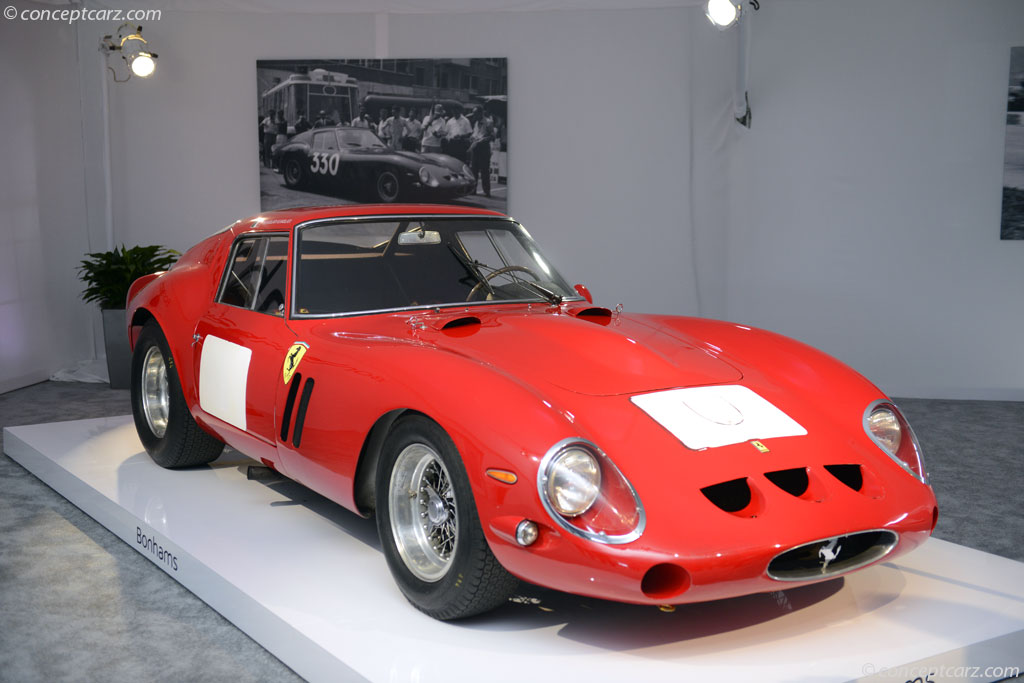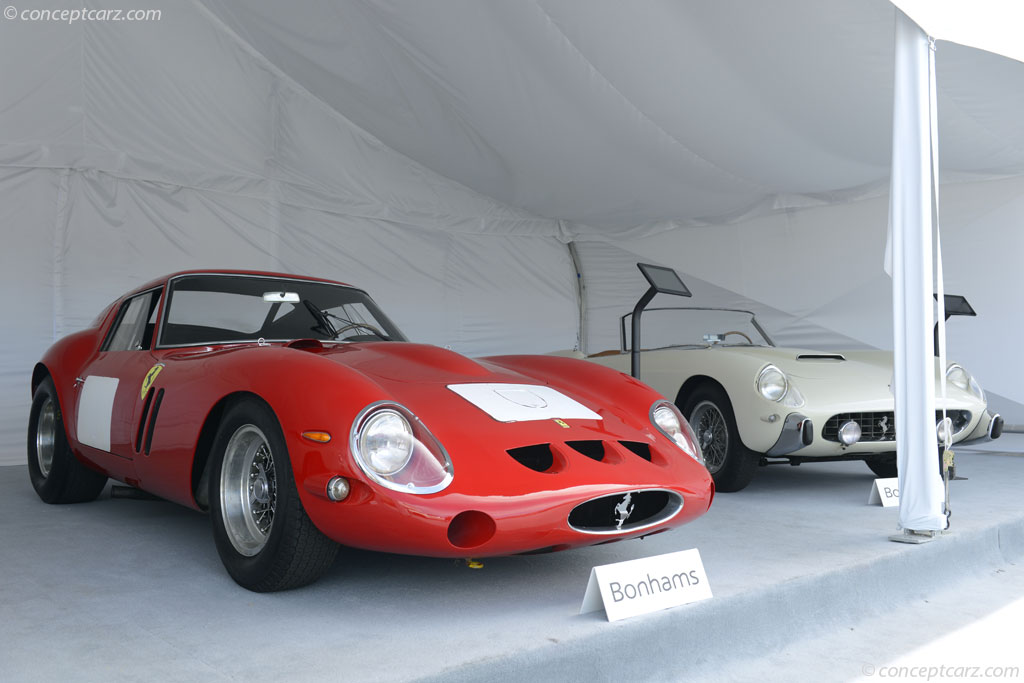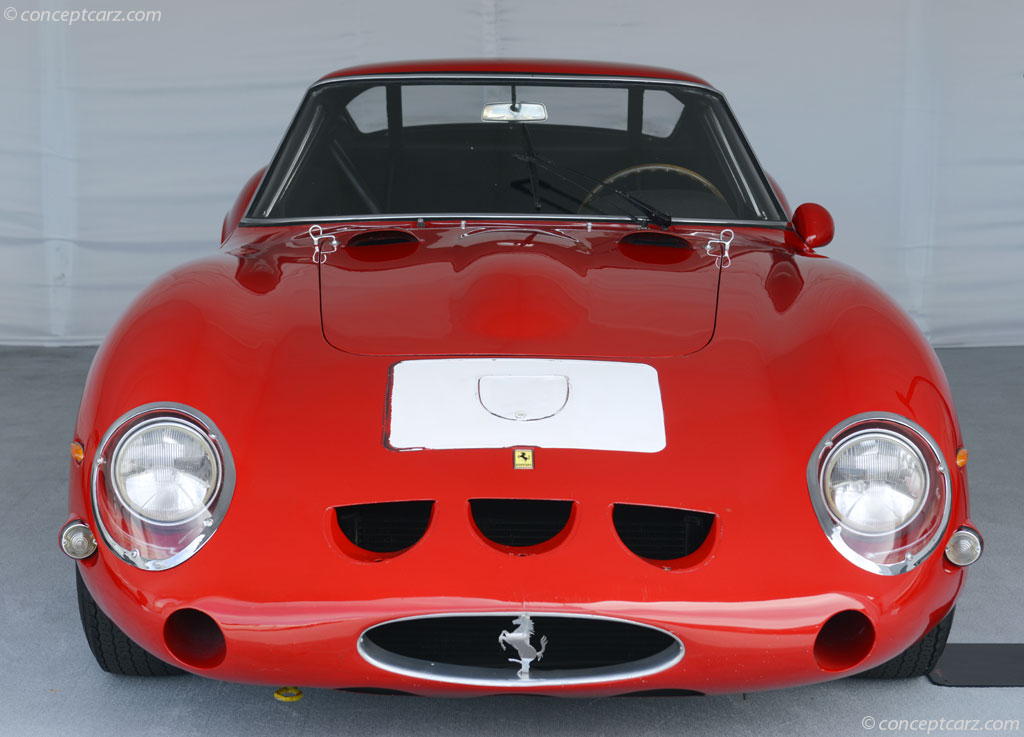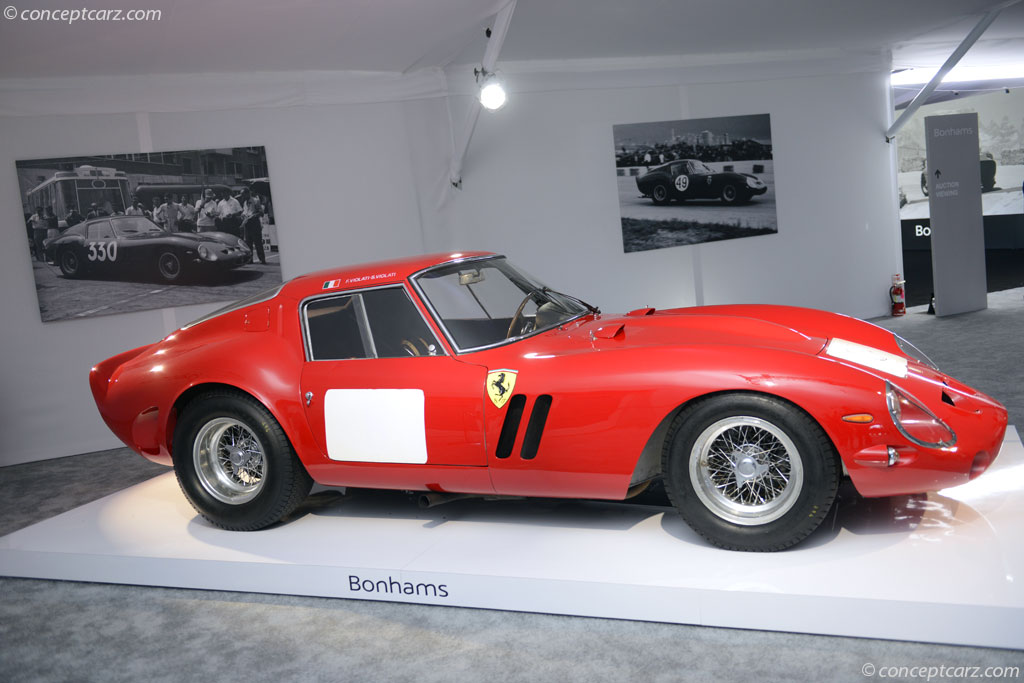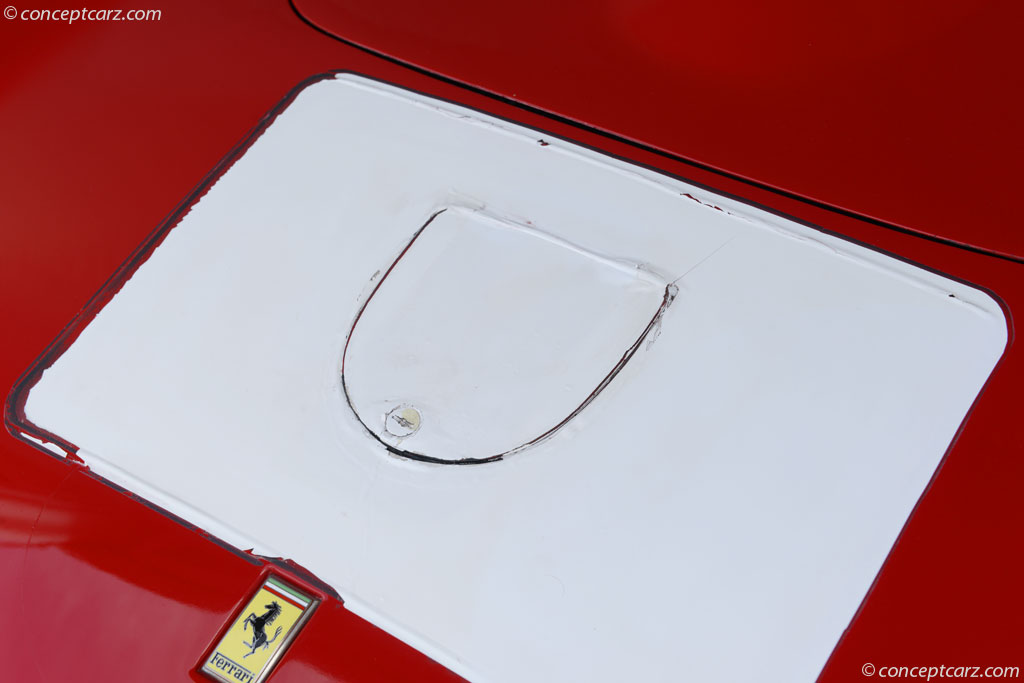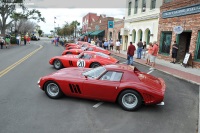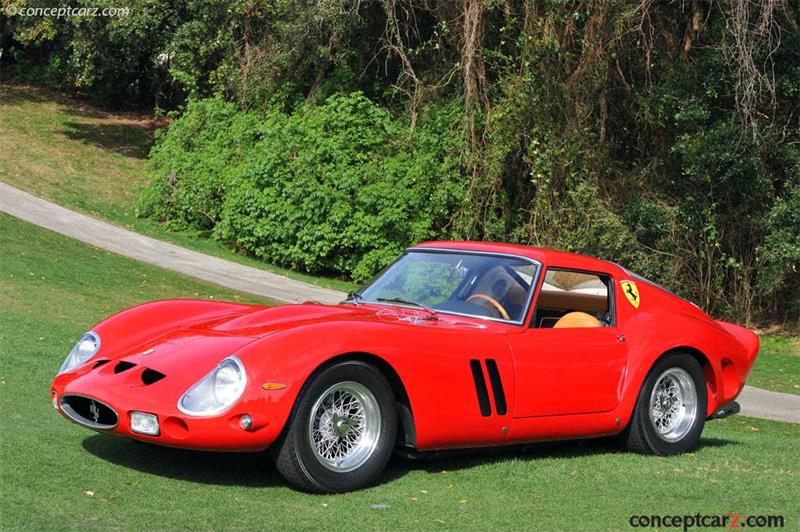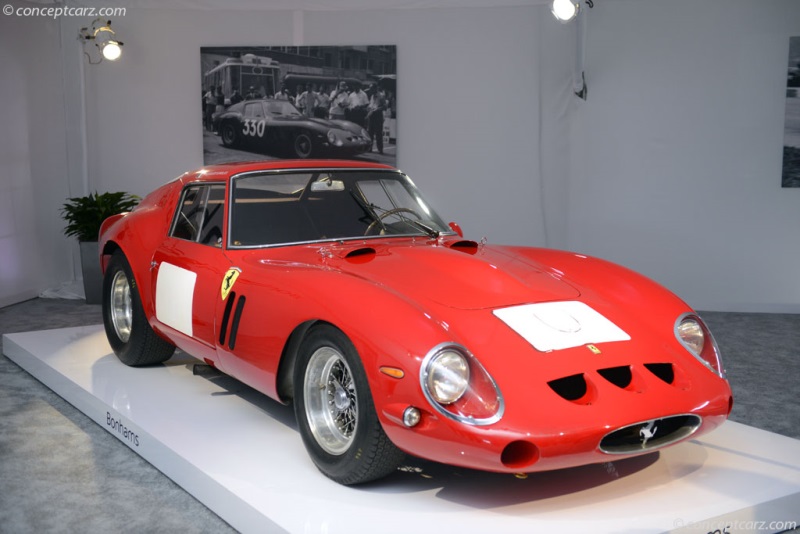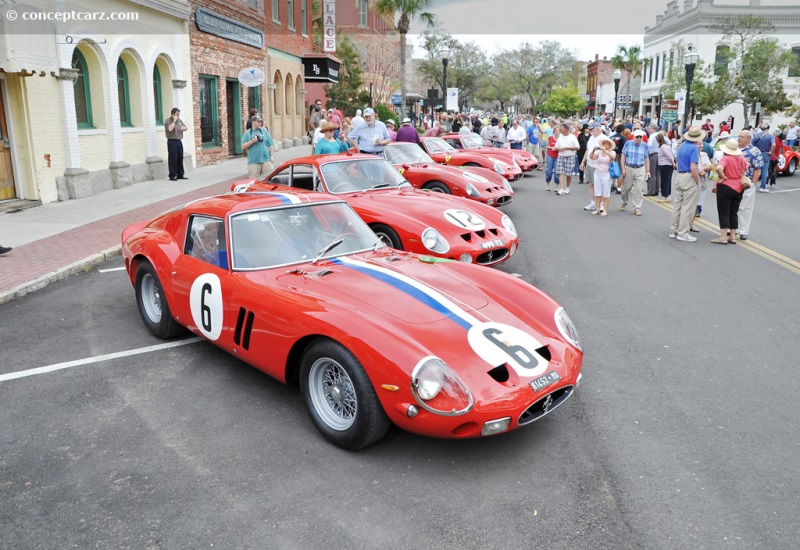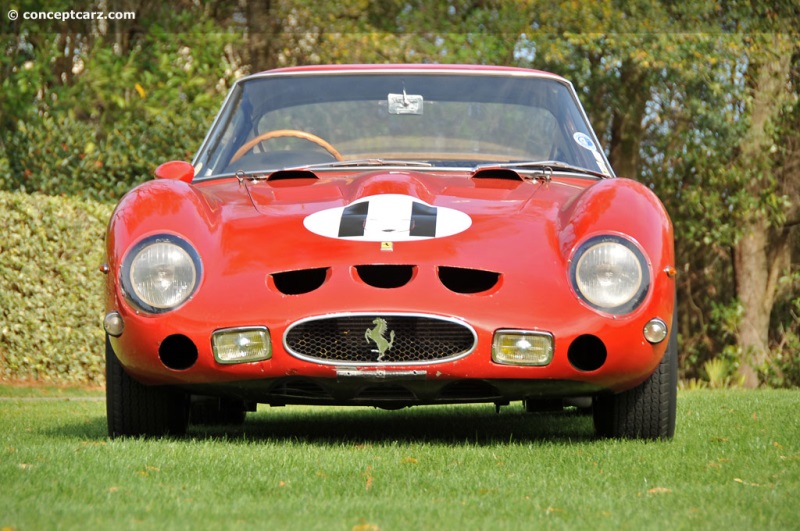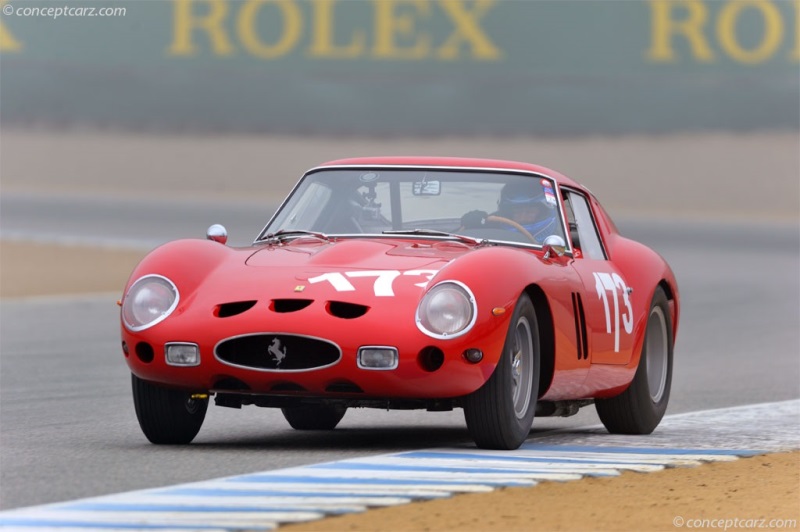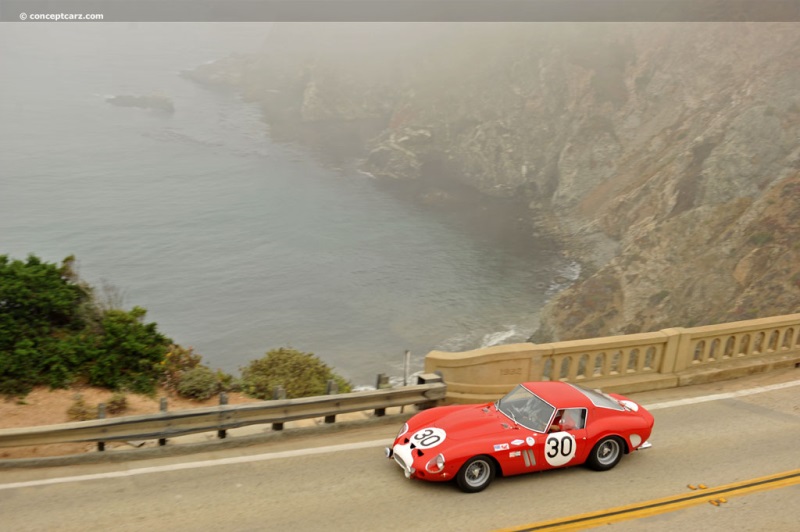Image credit: © conceptcarz.com (Reproduction Or reuse prohibited).
Chassis number 3851GT was built in September of 1962 and was sold new to French privateer Jo Schlesser. It was the 19th example created, although two of the preceding examples had been 330 GTOs with 4-litre engines instead of the GT-homologated 3-liter '250' units, so this may be considered the 17th 250 GTO. When new, it was finished in metallic pale grey with lengthwise red, white and blue centerline stripes.
Schlesser immediately entered the car in the annual Tour de France Automobile, run that year from September 15-23. Schlesser shared seat time with Parisian Henri Oreiller. The 1962 Tour de France Automobile spanned 3,418 miles; twelve assorted Ferrari 250 GTs were entered. Chassis 3851GT would finish the race in second place.
The second racing event for 3851GT was at Montlhéry Autodrome in the October 7 Coupes du Salon. During the race, Oreiller crashed fatally and the car was badly damaged after hitting a trackside building. Schlesser had the car returned to the factory for repair to as-new condition and subsequent re-sale. The work continued through the following winter and upon completion, was sold to a new Italian owner, Paolo Colombo.
Colombo entered the car as early as April 7, 1963, in national hill-climb competition. He set third fastest time in his class and placed 7th fastest overall. He contested that year's Italian national championship hill-climb series under the Scuderia Trentina banner, competing in no fewer than 14 further hill-climb rounds during that summer-into-Fall season. He scored Gran Turismo class victories in 12 of those events.
At the end of the season, the car was sold to Ernesto Prinoth. Mr. Prinoth raced 3851GT under the Scuderia Dolomiti Bolzano banner. Starting at Stallavena-Boscochiesanuova on April 5, 1964, and ending the year by winning his class again in the Preis von Tyrol aerodrome race at Innsbruck, Austria, on October 4, he won his GT Category six more times. Ernesto Prinoth also won his class and placed second overall in the year's Preis von Wien circuit race at Aspern aerodrome outside Vienna, Austria, and set second fastest GT time at the Coppa Consuma.
On September 6th of 1964, he raced 3851GT in the hour-long Coppa Inter-Europa GT race supporting that year's Formula 1 Italian Grand Prix at Monza Autodrome. Unfortunately, during that race, he crashed the car, rolling it into the trackside undergrown. The cabin of the roof was caved-in, and its body panels were badly dented. The damage was largely cosmetic and required just three weeks to repair. The car was ready for Prinoth where it scored that circuit-racing class win and finished second overall in the Innsbruck aerodrome race.
The car's next caretaker was Fabrizio Violati, who purchased the vehicle in 1965 for 2,500,000 Lire. Mr. Violati would own the car for 49 years. From 1979, he competed with 3851GT in Historic racing, under the Scuderia Campidoglio Motori banner. In 1985, he was the European FIA Historic Champion. When not competing with the car, it was on display in his Maranello Rosso museum in San Marino.
Fabrizio Violati passed away on January 22, 2010, aged 74.
In 2014, this historically important GTO was offered for sale at the Quail Lodge by Bonham's Auction. When the hammer fell for the third and final time, the car had been sold for $38,115,000 including buyer's premium.
The car has side-exit exhausts rather than the standard long tail-pipe system. It remains in its road-race/rally configuration as campaigned by its owner for 45 years until his passing in 2010.By Daniel Vaughan | Dec 2014
Schlesser immediately entered the car in the annual Tour de France Automobile, run that year from September 15-23. Schlesser shared seat time with Parisian Henri Oreiller. The 1962 Tour de France Automobile spanned 3,418 miles; twelve assorted Ferrari 250 GTs were entered. Chassis 3851GT would finish the race in second place.
The second racing event for 3851GT was at Montlhéry Autodrome in the October 7 Coupes du Salon. During the race, Oreiller crashed fatally and the car was badly damaged after hitting a trackside building. Schlesser had the car returned to the factory for repair to as-new condition and subsequent re-sale. The work continued through the following winter and upon completion, was sold to a new Italian owner, Paolo Colombo.
Colombo entered the car as early as April 7, 1963, in national hill-climb competition. He set third fastest time in his class and placed 7th fastest overall. He contested that year's Italian national championship hill-climb series under the Scuderia Trentina banner, competing in no fewer than 14 further hill-climb rounds during that summer-into-Fall season. He scored Gran Turismo class victories in 12 of those events.
At the end of the season, the car was sold to Ernesto Prinoth. Mr. Prinoth raced 3851GT under the Scuderia Dolomiti Bolzano banner. Starting at Stallavena-Boscochiesanuova on April 5, 1964, and ending the year by winning his class again in the Preis von Tyrol aerodrome race at Innsbruck, Austria, on October 4, he won his GT Category six more times. Ernesto Prinoth also won his class and placed second overall in the year's Preis von Wien circuit race at Aspern aerodrome outside Vienna, Austria, and set second fastest GT time at the Coppa Consuma.
On September 6th of 1964, he raced 3851GT in the hour-long Coppa Inter-Europa GT race supporting that year's Formula 1 Italian Grand Prix at Monza Autodrome. Unfortunately, during that race, he crashed the car, rolling it into the trackside undergrown. The cabin of the roof was caved-in, and its body panels were badly dented. The damage was largely cosmetic and required just three weeks to repair. The car was ready for Prinoth where it scored that circuit-racing class win and finished second overall in the Innsbruck aerodrome race.
The car's next caretaker was Fabrizio Violati, who purchased the vehicle in 1965 for 2,500,000 Lire. Mr. Violati would own the car for 49 years. From 1979, he competed with 3851GT in Historic racing, under the Scuderia Campidoglio Motori banner. In 1985, he was the European FIA Historic Champion. When not competing with the car, it was on display in his Maranello Rosso museum in San Marino.
Fabrizio Violati passed away on January 22, 2010, aged 74.
In 2014, this historically important GTO was offered for sale at the Quail Lodge by Bonham's Auction. When the hammer fell for the third and final time, the car had been sold for $38,115,000 including buyer's premium.
The car has side-exit exhausts rather than the standard long tail-pipe system. It remains in its road-race/rally configuration as campaigned by its owner for 45 years until his passing in 2010.By Daniel Vaughan | Dec 2014
It isn't often a sportscar manufacturer manages to build a car capable of contesting so many genres of motor-racing. It is practically impossible for a factory to build one that is successful in all of them as well. Sure, the car would be an incredible track car, but never legal for the street. However, the famed outfit from Maranello would achieve this incredibly elusive feat when it built the 250 GTO.
Originally designed to meet the requirements of the 3-liter FIA GT World Championship category, the 250 GTO would end up in a class unto itself. Powered by a 3-liter V12, and with a Scaglietti-designed body to die for, the GTO would not only look good dominating the GT World Championship two straight seasons, it would also look good as it powered its way to victories in hillclimbs, as well as, just going down the street. Pushing the best of the prototypes of the day, and yet, legal for the street, the 250 GTO was certainly the ultimate in its day.
Only a total of 39 would ever be produced that would be considered from the GTO family. Of those 39, only 31 would be from the 1962-1963 line of 250 GTO. Among those 31, only 28 are known to have been fitted with the original 3-liter V12 engine. The rest would become '330'GTOs fitted with 4-liter V12s.
The 17th, and perhaps the best, of those 31 with the true 3-liter V12 would be chassis 3851GT. Nearly all of the 250 GTOs that would be built have an impressive racing pedigree. However, few would match this car's longevity and success over such a period of time.
Completed at the end of the 1962 season, 3851GT would originally be finished in metallic pale grey with a red, white and blue stripes running down the centerline of the car. The car's first owner would be a privateer that certainly knew how to hustle a car around a circuit. The Frenchman, Jo Schlesser, would take and compete with the car. Co-driving with Henri Oreiller, Schlesser would enter 3851GT in the Tour de France Automobile. Schlesser was an up-and-coming talent. Oreiller had earned great fame as a resistance fighter during the war and a fearless downhill skier afterward. Henri would go on to win a couple of gold medals for France in the downhill with a nearly unheard of gap of some four seconds over the second place finisher. He seemed the ideal co-driver with Schlesser behind the wheel of the 250 GTO. Splitting up the workload between the hillclimbs and circuits, the pair would end up finishing 2nd place. It is highly likely they could have won had they, not unlike the other favored drivers at the wheel of the new 250 GTOs, not taken unnecessary risks at times.
Sadly, in the very next event, Oreiller would crash the GTO killing himself and mangling the car terribly. Schlesser would be devastated and would return the car to Maranello. Being one of the powerful 250 GTOs, 3851GT wasn't going to sit around long and it would be rebuilt over the winter of 1962 and 1963 and would then be delivered to Paolo Colombo. Colombo was not a professional driver but he was a regular on the hillclimbing scene. Racing under the Scuderia Trentina name, Colombo would contest the Italian national hillclimb championship. In his first event he would finish 7th overall and 3rd within his class. This would be one of his worse showings over the course of a year in which he would score no less than 12 class victories. At Mont Ventoux, Colombo could have made it 13 class victories had it not been for a small error that cost him some valuable seconds.
Not surprisingly, 3851GT would attract a number of admirers, one of those being Ernesto Prinoth, an automotive businessman who had a garage in Groden. Famous for Prinoth AG, a builder of snow vehicles, Prinoth was certainly a man who enjoyed sport and adventure. He would take part in some Formula One races driving for Scuderia Dolomiti in a Lotus-Climax 18 scoring mixed results. However, when he decided to make the switch to GT racing with the GTO, he would be virtually unbeatable scoring more than a half dozen victories over the course of the 1964 season.
Sadly, the car would suffer an incredible crash at Monza later on in the year. The body would be extensively damaged. Nonetheless, the car would be quickly repaired and Prinoth would complete the year with a 2nd overall finish at Innsbruck.
At the end of the year, Prinoth would be left with a successful, but used, 250 GTO. Fabrizio Violati would help make the decision for him. A racing fan for years, Violati would have a dream of owning a Ferrari. Ever since he had seen the scuderia for the first time in 1947 he had determined to some day own a famous example of the mark. Violati would be a successful racer in his own right winning his class often in hillclimbs and other events. There would be an agreement to sell the car for around $4,000. This was a lot of money at the time and it would force Violati to hide the fact from his family. In fact, the only time he would take to the streets in the awesome GTO would be at night when no one would be able to tell it was him behind the wheel.
The car would not leave Violati's side for nearly 50 years. Over that time, he would have the opportunity to collector more than a couple of Ferraris. However, 3851GT still held the highest place of importance within his heart. Then, by the mid-1970s, he would determine to test the car's pedigree within historic racing. By 1985, he and the car would be the European FIA Historic Champions. He would also go on to win the 1989 Targa Florio Autostoriche.
In 1984, this man who had fallen in love with the Ferrari mark after seeing them for the first time in 1947, would be invited to Maranello by Enzo Ferrari himself. The reason for the visit would be an incredible moment in the man's life as Enzo would task him with forming Ferrari Club Italia.
Right up to Violati's death in 2010, 3851GT still figured prominently within his extensive collection of Ferraris. The car had been in his possession for 45 years to that point. It certainly was a part of the family.
Still with its original engine, the 1962-63 Ferrari 250 GTO, chassis 3851GT, would be offered for sale for the first time in nearly 50 years. Offered as part of the 2014 Bonhams Quail Lodge auction, the car would set a record selling for $38,115,000!
Well documented, successful and the apple of an owner's eye for half a century, it is not difficult to understand why 3851GT is considered the ultimate Ferrari. Violati wouldn't just end up with what he had long desired. He would end up with perhaps the most priceless Ferrari of them all.By Jeremy McMullen
Originally designed to meet the requirements of the 3-liter FIA GT World Championship category, the 250 GTO would end up in a class unto itself. Powered by a 3-liter V12, and with a Scaglietti-designed body to die for, the GTO would not only look good dominating the GT World Championship two straight seasons, it would also look good as it powered its way to victories in hillclimbs, as well as, just going down the street. Pushing the best of the prototypes of the day, and yet, legal for the street, the 250 GTO was certainly the ultimate in its day.
Only a total of 39 would ever be produced that would be considered from the GTO family. Of those 39, only 31 would be from the 1962-1963 line of 250 GTO. Among those 31, only 28 are known to have been fitted with the original 3-liter V12 engine. The rest would become '330'GTOs fitted with 4-liter V12s.
The 17th, and perhaps the best, of those 31 with the true 3-liter V12 would be chassis 3851GT. Nearly all of the 250 GTOs that would be built have an impressive racing pedigree. However, few would match this car's longevity and success over such a period of time.
Completed at the end of the 1962 season, 3851GT would originally be finished in metallic pale grey with a red, white and blue stripes running down the centerline of the car. The car's first owner would be a privateer that certainly knew how to hustle a car around a circuit. The Frenchman, Jo Schlesser, would take and compete with the car. Co-driving with Henri Oreiller, Schlesser would enter 3851GT in the Tour de France Automobile. Schlesser was an up-and-coming talent. Oreiller had earned great fame as a resistance fighter during the war and a fearless downhill skier afterward. Henri would go on to win a couple of gold medals for France in the downhill with a nearly unheard of gap of some four seconds over the second place finisher. He seemed the ideal co-driver with Schlesser behind the wheel of the 250 GTO. Splitting up the workload between the hillclimbs and circuits, the pair would end up finishing 2nd place. It is highly likely they could have won had they, not unlike the other favored drivers at the wheel of the new 250 GTOs, not taken unnecessary risks at times.
Sadly, in the very next event, Oreiller would crash the GTO killing himself and mangling the car terribly. Schlesser would be devastated and would return the car to Maranello. Being one of the powerful 250 GTOs, 3851GT wasn't going to sit around long and it would be rebuilt over the winter of 1962 and 1963 and would then be delivered to Paolo Colombo. Colombo was not a professional driver but he was a regular on the hillclimbing scene. Racing under the Scuderia Trentina name, Colombo would contest the Italian national hillclimb championship. In his first event he would finish 7th overall and 3rd within his class. This would be one of his worse showings over the course of a year in which he would score no less than 12 class victories. At Mont Ventoux, Colombo could have made it 13 class victories had it not been for a small error that cost him some valuable seconds.
Not surprisingly, 3851GT would attract a number of admirers, one of those being Ernesto Prinoth, an automotive businessman who had a garage in Groden. Famous for Prinoth AG, a builder of snow vehicles, Prinoth was certainly a man who enjoyed sport and adventure. He would take part in some Formula One races driving for Scuderia Dolomiti in a Lotus-Climax 18 scoring mixed results. However, when he decided to make the switch to GT racing with the GTO, he would be virtually unbeatable scoring more than a half dozen victories over the course of the 1964 season.
Sadly, the car would suffer an incredible crash at Monza later on in the year. The body would be extensively damaged. Nonetheless, the car would be quickly repaired and Prinoth would complete the year with a 2nd overall finish at Innsbruck.
At the end of the year, Prinoth would be left with a successful, but used, 250 GTO. Fabrizio Violati would help make the decision for him. A racing fan for years, Violati would have a dream of owning a Ferrari. Ever since he had seen the scuderia for the first time in 1947 he had determined to some day own a famous example of the mark. Violati would be a successful racer in his own right winning his class often in hillclimbs and other events. There would be an agreement to sell the car for around $4,000. This was a lot of money at the time and it would force Violati to hide the fact from his family. In fact, the only time he would take to the streets in the awesome GTO would be at night when no one would be able to tell it was him behind the wheel.
The car would not leave Violati's side for nearly 50 years. Over that time, he would have the opportunity to collector more than a couple of Ferraris. However, 3851GT still held the highest place of importance within his heart. Then, by the mid-1970s, he would determine to test the car's pedigree within historic racing. By 1985, he and the car would be the European FIA Historic Champions. He would also go on to win the 1989 Targa Florio Autostoriche.
In 1984, this man who had fallen in love with the Ferrari mark after seeing them for the first time in 1947, would be invited to Maranello by Enzo Ferrari himself. The reason for the visit would be an incredible moment in the man's life as Enzo would task him with forming Ferrari Club Italia.
Right up to Violati's death in 2010, 3851GT still figured prominently within his extensive collection of Ferraris. The car had been in his possession for 45 years to that point. It certainly was a part of the family.
Still with its original engine, the 1962-63 Ferrari 250 GTO, chassis 3851GT, would be offered for sale for the first time in nearly 50 years. Offered as part of the 2014 Bonhams Quail Lodge auction, the car would set a record selling for $38,115,000!
Well documented, successful and the apple of an owner's eye for half a century, it is not difficult to understand why 3851GT is considered the ultimate Ferrari. Violati wouldn't just end up with what he had long desired. He would end up with perhaps the most priceless Ferrari of them all.By Jeremy McMullen
2014 Bonhams Quail Lodge Auction
Sale Price :
USD $38,115,000
Recent Sales of the Ferrari 250 GTO
(Data based on Model Year 1962 sales)
| 1962 Ferrari 250 GTO by Scaglietti Chassis#: 3413 Sold for USD$48,405,000 2018 RM Sothebys : Monterey |   |
| 1962-63 FERRARI 250 GTO BERLINETTA Chassis#: 3851GT Sold for USD$38,115,000 2014 Bonhams Quail Lodge Auction |   |
Ferrari 250 GTOs That Failed To Sell At Auction
1962 Ferrari 250 GTO's that have appeared at auction but did not sell.
| Vehicle | Chassis | Event | High Bid | Est. Low | Est. High |
|---|
Vehicles With Comparable Market Values
Similar sales to the $43,260,000 range.
1962 Ferrari 250 GTO
• Additional valuation insight and sales data• History
• Specifications
• Image gallery
• Other Ferrari 250 GTO model years
